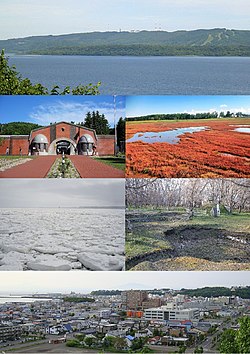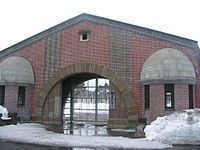Abashiri
Abashiri
網走市 | |
|---|---|
 Top: Panorama view of Mount Tento and Lake Abashiri, Second: Abashiri Prison Museum, View of salicornia europaea in Lake Notoro, Third: View of drift ice in Okhotsk Sea, Ainu Moyoro Midden Ruin Park, Bottom: Panorama view of downtown Abashiri (all item from left to right) | |
 Location of Abashiri in Hokkaido (Okhotsk Subprefecture) | |
| Coordinates: 44°1′N 144°16′E / 44.017°N 144.267°E | |
| Country | Japan |
| Region | Hokkaido |
| Prefecture | Hokkaido (Okhotsk Subprefecture) |
| Government | |
| • Mayor | Yōichi Mizutani (since December 2010) |
| Area | |
| • Total | 470.94 km2 (181.83 sq mi) |
| Population (February, 2020) | |
| • Total | 34,919 |
| • Density | 85.6/km2 (222/sq mi) |
| Time zone | UTC+09:00 (JST) |
| City hall address | Higashi Yon-chōme, Minami Roku-jō, Abashiri-shi, Hokkaidō 093-8555 |
| Climate | Dfb |
| Website | www |
| Symbols | |
| Flower | Ezo murasaki-tsutsuji (Rhododendron dauricum) |
| Mascot | Nipone (ニポネ) |
| Tree | Katsura |
Abashiri (網走市, Abashiri-shi) is a city located in Okhotsk Subprefecture, Hokkaido, Japan.
Abashiri is known as the site of the Abashiri Prison, a Meiji-era facility used for the incarceration of political prisoners. The old prison has been turned into a museum, but the city's new maximum-security prison is still in use.
As of 2008, the city has an estimated population of 40,333 and a density of 85.6 persons per km2 (222 persons per sq. mi.). The total area is 470.94 km2 (181.83 sq mi).
Etymology
[edit]There are various theories about the origin of the name 'Abashiri' and, because of that, the origin is unknown. All of those theories are based on the Kanji interpretation of the Ainu language.[1] These are the following theories.
- Apasiri (アパシリ) which is translated as "leaking ground". The reason behind this is that there was a cave, and water drops were falling inside like raindrops.
- Cipasiri (チパシリ). The name is based on an Ainu legend of a bird.
- Chipasiri (チパシリ). There used to be a white rock in the shape of a person wearing a hat on the south bank of Lake Abashiri, and it is said that the Ainu worshiped it.
History
[edit]The origin of the city's name is not known for certain, but it is agreed that it was derived from an Ainu word. A few among several of the candidates include apa-siri (leakage/ground) and ci-pa-sir ("the land we discovered").[2][3]
- March 1872: Abashiri Village (アバシリ村) founded, being given the name of Abashiri District in Kitami Province.
- 1875: The village name is rewritten in kanji (網走村, same pronunciation).
- 1902: Abashiri Village, Kitami Town, Isani Village, and Nikuribake Village, all in Abashiri District, merged to form Abashiri Town.
- 1915: Notoro Village, Mokoto Village merged.
- 1921: Memanbetsu Village (later Memanbetsu Town, merged into Ōzora in 2006) split.
- 1931: Boundary with Memanbetsu Town modified.
- February 11, 1947: Higashimokoto Village (merged into Ōzora in 2006) split. Abashiri Town becomes Abashiri City. All of the territories of Ōzora used to be a part of Abashiri.
Following the 1945 Soviet invasion of South Sakhalin,[4][5] Abashiri saw the resettlement of several Nivkh and Orok families from Karafuto; among them was Chiyo Nakamura (1906–1969), a Nivkh shaman from Poronaisk (Japanese: 敷香町, romanized: Shisuka-machi).[6][7][8] By 2004, the Nivkh-Orok community in Abashiri had apparently vanished.[9]
Geography
[edit]Abashiri is located in the eastern part of Okhotsk Subprefecture, about 50 kilometers east of Kitami. There are no tall mountains, but there are many hills. The Abashiri River flows through the city and there are three lakes (Lake Abashiri, Lake Notoro and Lake Tōfutsu) in the city as well. These lakes and Mount Tento belong to Abashiri Quasi-National Park.
Climate
[edit]The climate is humid continental with warm summer (Köppen: Dfb) as much of Hokkaido, similar to the south coast of New England.[10] Despite its reputation for extreme cold, Abashiri is not actually the coldest major town in Japan, being less cold in the winter than Obihiro and warmer in summer than Nemuro or Kushiro. Abashiri receives less precipitation than any other city in Japan because its location on the drift ice-affected Sea of Okhotsk,[11] which, however, causes Abashiri to receive less sunshine than the northeast coast since winter snowfall is heavier and fog less confined to the summer months when the Oyashio Current is strongest. During the winter, when Lake Abashiri freezes over, fog becomes a common occurrence.[12] Also, the harbor closes when it ices over.
| Climate data for Abashiri, 1991–2020 normals, extremes 1889−present | |||||||||||||
|---|---|---|---|---|---|---|---|---|---|---|---|---|---|
| Month | Jan | Feb | Mar | Apr | May | Jun | Jul | Aug | Sep | Oct | Nov | Dec | Year |
| Record high °C (°F) | 11.8 (53.2) |
11.1 (52.0) |
19.7 (67.5) |
31.9 (89.4) |
35.4 (95.7) |
34.0 (93.2) |
37.0 (98.6) |
37.6 (99.7) |
32.8 (91.0) |
27.7 (81.9) |
21.7 (71.1) |
17.6 (63.7) |
37.6 (99.7) |
| Mean daily maximum °C (°F) | −2.2 (28.0) |
−2.0 (28.4) |
2.3 (36.1) |
9.1 (48.4) |
14.6 (58.3) |
17.7 (63.9) |
21.4 (70.5) |
23.3 (73.9) |
20.7 (69.3) |
15.0 (59.0) |
7.6 (45.7) |
0.7 (33.3) |
10.7 (51.3) |
| Daily mean °C (°F) | −5.1 (22.8) |
−5.4 (22.3) |
−1.3 (29.7) |
4.5 (40.1) |
9.8 (49.6) |
13.5 (56.3) |
17.6 (63.7) |
19.6 (67.3) |
16.8 (62.2) |
10.9 (51.6) |
4.0 (39.2) |
−2.4 (27.7) |
6.9 (44.4) |
| Mean daily minimum °C (°F) | −8.9 (16.0) |
−9.6 (14.7) |
−4.9 (23.2) |
0.6 (33.1) |
5.8 (42.4) |
10.2 (50.4) |
14.6 (58.3) |
16.6 (61.9) |
13.4 (56.1) |
7.0 (44.6) |
0.4 (32.7) |
−6.0 (21.2) |
3.3 (38.0) |
| Record low °C (°F) | −29.2 (−20.6) |
−25.7 (−14.3) |
−23.2 (−9.8) |
−12.4 (9.7) |
−5.4 (22.3) |
0.1 (32.2) |
2.8 (37.0) |
5.9 (42.6) |
3.3 (37.9) |
−4.6 (23.7) |
−11.3 (11.7) |
−18.0 (−0.4) |
−29.2 (−20.6) |
| Average precipitation mm (inches) | 53.8 (2.12) |
41.9 (1.65) |
39.3 (1.55) |
51.2 (2.02) |
64.1 (2.52) |
68.1 (2.68) |
85.8 (3.38) |
115.3 (4.54) |
115.0 (4.53) |
88.2 (3.47) |
58.1 (2.29) |
63.6 (2.50) |
844.2 (33.24) |
| Average snowfall cm (inches) | 90 (35) |
69 (27) |
52 (20) |
15 (5.9) |
1 (0.4) |
0 (0) |
0 (0) |
0 (0) |
0 (0) |
0 (0) |
13 (5.1) |
71 (28) |
312 (123) |
| Average snowy days | 19.7 | 15.9 | 13.4 | 3.7 | 0.3 | 0 | 0 | 0 | 0 | 0.1 | 3.7 | 14.8 | 71.6 |
| Average relative humidity (%) | 72 | 73 | 70 | 68 | 73 | 80 | 82 | 81 | 76 | 71 | 68 | 69 | 74 |
| Mean monthly sunshine hours | 111.5 | 137.9 | 172.4 | 178.6 | 187.1 | 172.2 | 167.6 | 163.9 | 162.9 | 157.4 | 121.2 | 117.4 | 1,850.1 |
| Source 1: JMA[13] | |||||||||||||
| Source 2: JMA[14] | |||||||||||||
Demographics
[edit]Per Japanese census data,[15] the population of Abashiri has declined in recent decades.
| Year | Pop. | ±% |
|---|---|---|
| 1970 | 43,904 | — |
| 1980 | 44,777 | +2.0% |
| 1990 | 44,416 | −0.8% |
| 2000 | 43,395 | −2.3% |
| 2010 | 40,998 | −5.5% |
| 2020 | 35,759 | −12.8% |
Economy
[edit]Because of its short 130-day growing season, the crops in the region, such as oats, potatoes, and beans, are required to be hardy. Hay is also grown for local cows, horses, and sheep.[12] The sea is an important part of the community as well as the economy, as fishing, oysters, and seaweed are important means of livelihood.[12]
Transportation
[edit]Air
[edit]Memanbetsu Airport is located in nearby Ōzora.
Rail
[edit]Abashiri is an important local port city and railway terminal (Abashiri Station).
- JR Hokkaido Sekihoku Main Line: Yobito - Abashiri
- JR Hokkaido Senmō Main Line: Abashiri - Katsuradai - Masuura - Mokoto - Kitahama
Education
[edit]Universities
[edit]- Tokyo University of Agriculture, Okhotsk campus
High schools
[edit]- Hokkaido Abashiri Minamigaoka High School
- Hokkaido Abashiri Keiyo High School
Sister cities
[edit]![]() Port Alberni, British Columbia, Canada - Each year many students participate in student exchange programs between the two cities.[16]
Port Alberni, British Columbia, Canada - Each year many students participate in student exchange programs between the two cities.[16]
Sights
[edit]Hokkaido has a brewery called Abashiri which sells a range of beers,[17][18] including Bilk, a blend of beer and milk.[19] Abashiri is also home to a flower garden with a wide range of flowers.[12]
In the winter, tourists visit the city to watch the drift ice.
-
Drift ice off Abashiri
-
Abashiri's sightseeing ship & icebreaker Aurora II
Museums
[edit]- Okhost Ryuhyo Museum
Culture
[edit]Mascot
[edit]
Abashiri's mascot is Nipone (ニポネ). She is a plankton who the ability to gain flight with her cape. Her job is to protect everyone from criminal activities (such as terrorism and corruption), outbreak of warfare, natural disasters, health crisis (such as disease outbreaks) or anything that pose a risk to everyone's lives. She usually rests with her "nipopo" (totem pole) helmet and loves ingredients produced from the city. Her birthday is November 22.[20]
References
[edit]- ^ "市名の由来と紋章|網走市の紹介|網走市". www.city.abashiri.hokkaido.jp. Retrieved 2022-12-05.
- ^ "市名の由来と紋章". 網走市. Retrieved 2015-11-05.
- ^ "アイヌ語地名リスト ア~イチ P1-10" (PDF). 北海道 環境生活部 アイヌ政策推進室. 2007. Archived (PDF) from the original on 2014-01-11. Retrieved 2017-10-20.
- ^ Carson, Cameron (2015). "Karafuto 1945: An examination of the Japanese under Soviet rule and their subsequent expulsion". Western Michigan University. Retrieved 2024-04-20.
- ^ Chaussonnet, Valerie (1995). Crossroads Alaska: Native Cultures of Alaska and Siberia. Washington, D.C.: Smithsonian Institution, Arctic Studies Center. p. 35. ISBN 1-56098-661-1.
- ^ "昭和22年(1947年)~昭和50年(1975年)" [From 1947 to 1975] (in Japanese). City of Abashiri. Retrieved 2024-04-20.
- ^ 国文学年次別論文集: 平成5(1993)年. 近代 [Annual Collection of Essays on Japanese Literature: 1993. Modern] (in Japanese). Vol. 2003. Hōbun Shuppan. 1993. pp. 132–33.
- ^ Tanaka Ryō (1993). サハリン北緯 50度線 [Sakhalin at the 50th Parallel North] (in Japanese). 草の根出版会 (Grassroots Press). p. 38. ISBN 9784876480975.
- ^ Chuner Taksami (2004). Siro Sasaki (ed.). "Культурное наследие нивхов : Этнографические коллекции нивхов в музеях Японии" [Cultural heritage of the Nivkhs: Ethnographic collections of the Nivkhs in museums in Japan] (PDF) (in Russian). National Museum of Ethnology, Osaka. pp. 37–38, 41, 45–46, 64. Retrieved 2024-04-20.
- ^ "Abashiri Climate Abashiri Temperatures Abashiri Weather Averages". www.abashiri.climatemps.com. Retrieved 2018-12-19.
- ^ "Japan Climate Index". www.climate-charts.com. Archived from the original on 23 December 2007. Retrieved 22 May 2022.
- ^ a b c d Kojima, Reikichi (1997). "Abashiri". In Johnston, Bernard (ed.). Collier's Encyclopedia. Vol. I A to Ameland (First ed.). New York, NY: P.F. Collier. p. 7.
- ^ 観測史上1~10位の値(年間を通じての値). JMA. Retrieved February 17, 2022.
- ^ 気象庁 / 平年値(年・月ごとの値). JMA. Retrieved February 17, 2022.
- ^ "Abashiri (Hokkaidō, Japan) - Population Statistics, Charts, Map, Location, Weather and Web Information". Retrieved 18 July 2024.
- ^ Sister city of Abashiri
- ^ "Abashiri Beer - RateBeer". ratebeer.com. 2011. Retrieved 27 October 2011.
- ^ "北海道 網走地ビール の網走ビール株式会社|トップページ". www.takahasi.co.jp. Archived from the original on 2013-03-14. Retrieved 2009-08-25.
- ^ "Milk + Beer = Bilk". Japan Probe. Archived from the original on 2009-07-10. Retrieved 2009-08-25.
- ^ "ニポネの紹介". Abashiri.
External links
[edit]- Official Website (in Japanese)
- Abashiri Prison Museum Official Website (in Japanese)
- Abashiri Tourist Information (in English)






